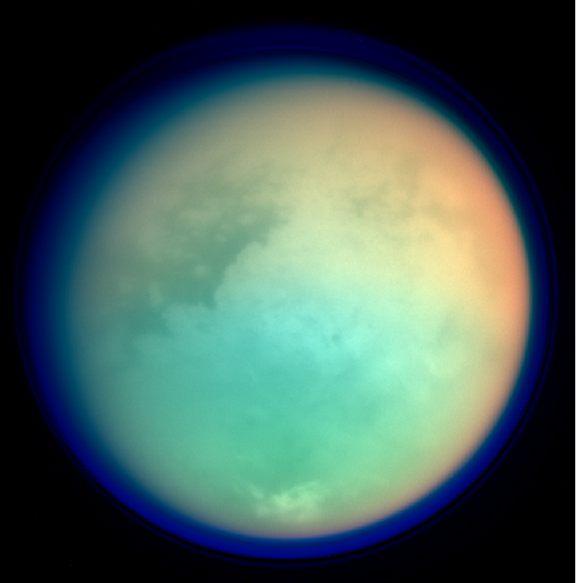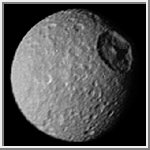Radar Images Suggest a Saturn Moon's Landscape Contains Basins of Ice
By JOHN NOBLE WILFORD
http://www.nytimes.com/2004/10/29/science/space/29titan.html
PASADENA, Calif., Oct. 28 - The Cassini spacecraft's first radar images of Saturn's largest moon, Titan, have revealed a diverse frozen landscape of bright streaks that may be ice ridges or wind-driven deposits, and dark regions that are probably
smooth basins filled with dirty ice - or, in some places, lakes of exotic liquid, perhaps methane.
If they did not dispel the mystery of Titan, the black-and-white radar images gave scientists tantalizing clues to challenge or revise some hypotheses about the nature of the Titanian surface, long hidden beneath a dense atmosphere.
It is the only moon in the solar system with a substantial atmosphere and evidence of a complex organic, or carbon-based, chemistry that could yield insights into processes that led to life on the early Earth.
In its encounter with Titan on Tuesday, the Cassini spacecraft penetrated the opaque atmosphere with cameras, infrared sensors and a radar system designed to map hidden landscapes. The first processed radar images were made public Thursday by scientists here at NASA's Jet Propulsion Laboratory. They appeared to show more features than could be seen in the regular photographs, released soon after the flyby.
At a news conference, Dr. Charles Elachi, director of the laboratory, who is also leader of the radar investigation, said the radar survey covered a strip 75 miles wide and 1,200 miles long, about 1 percent of the planet-size moon's surface. Bright regions in the images represented rough terrain, and darker areas were interpreted as smooth, flat surfaces.
Dr. Elachi noted a 150-mile-wide dark region that looked (as a researcher's daughter put it) like a Halloween cat
(see link above). The region, he said, was probably a smooth basin with icy surfaces and possibly lakes of liquids.
On Wednesday, scientists examining conventional photographs and other data said they saw no evidence of bodies of liquids on Titan. Some members of the radar imaging team said they thought it more likely that the smooth surfaces were expanses of dirty ice, frozen water mixed with tarlike hydrocarbons related to methane.
Dr. Ralph Lorenz of the University of Arizona reported that measurements of Titan's surface heat "were consistent with a surface covered in organic material" and that the dark regions were richer in organics than the brighter areas.
Even though Titan's mass is estimated to be half water and half rock, any lake would not be liquid water. It would be frozen solid on a surface with temperatures as low as minus 290 degrees Fahrenheit.
Any liquid is more likely to be a hydrocarbon like methane. Titan's atmosphere is composed primarily of nitrogen, with a significant amount of methane.
Dr. Elachi said the Halloween cat in the radar image looked "similar to a lake on Earth, except you can't drink the liquid." Dr. Jonathan Lunine, a planetary scientist at the University of Arizona, noted, "How much of the surface is liquid and how much solid is still unclear."
The landscape surveyed in the close approach was definitely flat, scientists said, with variations in elevation of little more than 150 feet. No craters were detected, though such a large moon would have been struck by asteroids many times. Scientists suggested that the craters might have been filled with glacial movements of water ice and a steady rain of hydrocarbons from the sky.
"Titan is really covered in organics," Dr. Lorenz said.
Nor were any mountains or deep valleys detected by the radar. But it revealed many surface streaks, particularly in the equatorial region. Scientists said these could be ridges of ice or deposits of windblown material. Similar streaks were seen in conventional photographs taken by the Cassini craft.
Other measurements indicated that on Titan the average winds blow at speeds comparable to those on Earth. Dr. Alfred McEwen, another Arizona scientist and a member of the imaging team, said the winds appeared to be the primary cause of most of the observed streakiness. Winds may be moving solid material around, possibly even moving liquids around, Dr. McEwen said.
In other radar images, scientists found many signs of fractures in the frozen surface, in places giving the appearance of a cracked eggshell. It is one more of the puzzles that confront Cassini scientists now that the spacecraft, which reached an orbit of Saturn on June 30, has completed the first close-up reconnaissance of Titan.
Before that, Dr. Lunine said, more distant observations showed that methane was chemically active in Titan's atmosphere and that it was probably recombining to make more complex organic molecules.
But for all scientists knew, Titan's surface was geologically dead. Now, Dr. Lunine said, scientists "can see that Titan is an extremely dynamic place not only in its atmosphere but on the surface itself."
 i love this kind of stuff
i love this kind of stuff


